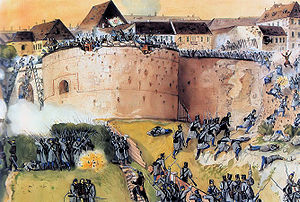| Siege of Buda | |||||||
|---|---|---|---|---|---|---|---|
| Part of the Hungarian Revolution of 1848 | |||||||
 Painting by Mór Than | |||||||
| |||||||
| Belligerents | |||||||
|
|
| ||||||
| Commanders and leaders | |||||||
|
|
| ||||||
| Strength | |||||||
|
Total: 34,277 men – I. corps: 9,465 – II. corps: 7,799 – III. corps: 9,419 – VII. corps –– 15. division: 4,883 –– 12. division: 2,711 142 cannons |
4,890 men 85 cannons | ||||||
| Casualties and losses | |||||||
|
368–427 dead 700–691 wounded |
710 dead 4,204 captured[1] 248 cannons | ||||||
The siege of Buda took place at Buda castle (called Festung Ofen in German), part of the twin capital cities of the Kingdom of Hungary. The Hungarian revolutionary army was led by General Artúr Görgei during the Hungarian War of Independence. Part of the Spring Campaign, the siege began on 4 May 1849, ending with the Hungarian capture of the castle by assault on 21 May.
Buda Castle was the only fortress throughout the entire war to be taken by storm by the besiegers on either side. All other fortresses capitulated following agreements between besiegers and besieged. The siege of Buda was also the shortest siege of the war (18 days). The senseless bombardment of Pest by Austrian commander Major General Heinrich Hentzi caused destruction of classic buildings on the shores of the Danube. Other regions of the capitals also suffered heavy damage due to the artillery duels between the two sides.
The capture of Buda Castle completed the liberation of the Hungarian capital cities (Buda and Pest). Thanks to this, the second Hungarian revolutionary Government, led by Bertalan Szemere together with Governor-President Lajos Kossuth, returned from Debrecen, the interim capital of the Hungarian revolution, to the capital of Hungary.
On 21 May 1849, the same day as the capture of Buda, the two emperors Franz Joseph I of Austria and Tsar Nicholas I of Russia signed the final treaty in Warsaw, which agreed on the intervention in Hungary of 200,000 Russian soldiers (and an 80,000-strong reserve force, if necessary), in order to help the Austrian Empire crush the Hungarian revolution.[2]
- ^ Hermann 2013, pp. 32–33.
- ^ Chastain, James. "Russia in 1848 and 1849". Ohio University. Retrieved 10 January 2022.